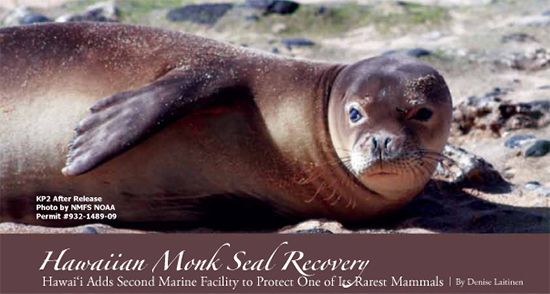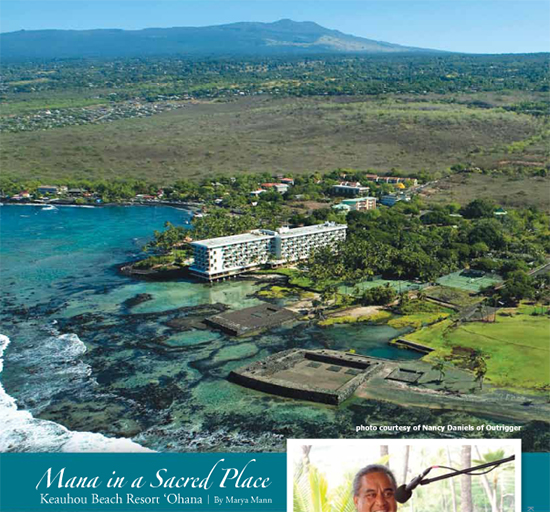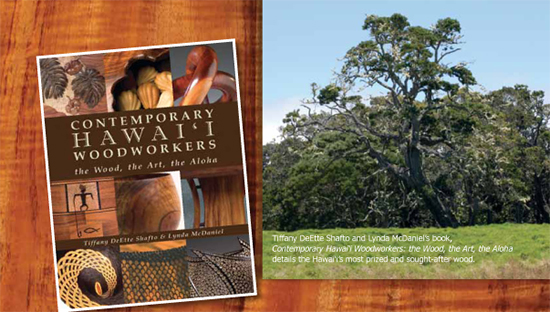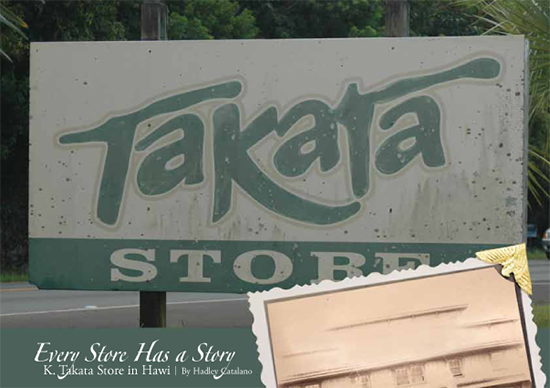
Hawaiian Monk Seal Recovery: Hawaii Adds Second Marine Facility to Protect One of Its Rarest Mammals
By Denise Laitinen
In 2009 when KP2 (Kauai Pup 2), an orphaned Hawaiian monk seal in waters off Moloka‘i needed medical attention, he was transported roughly 2,500 miles to the University of California Santa Cruz Long Marine Laboratory for care because there were no long-term monk care seal facilities in Hawai‘i.
Starting this spring, if other monk seals like KP2 need medical attention they’ll be able to receive quality treatment at a new monk seal hospital in Kailua-Kona.
Last September, The Marine Mammal Center (TMMC), one of the largest marine mammal facilities in the country, broke ground on the first-ever Hawaiian monk seal hospital in the state. It is designed to hold up to 10 seals at a time, and is expected to be near completion in Spring 2013.
The Center is working in collaboration with a number of groups including: NOAA Fisheries, the Hawaiian Monk Seal Recovery Team, Hawai‘i Wildlife Fund, the Kohala Center, NELHA, and others, in an effort to save Hawaiian monk seals.
“I think what cases like KP2 illustrate is that every time there’s a seal that needed medical attention or needed to be relocated, there really was nowhere to take it,” says Dr. Jason Turner, director of the Hilo Marine Mammal Response Network, a group comprised of volunteers who respond to Hawaiian monk seal sightings, birthing events, and deceased and stranded marine mammals.
“The alternative was short-term observation at the Waikīkī Aquarium or to be relocated to the UCSC Long Marine Laboratory in California,” adds Turner, who is also an associate professor in the Department of Marine Science at UH-Hilo.
“It’s my opinion, and I think a lot of people share my opinion, that the Marine Mammal Center is one of the best pinniped rehab places in the world. It’s the pinnacle of marine mammal response and their vets are some of the best in the world.”
So how did a California-based organization decide to build a Hawaiian monk seal hospital in Kailua-Kona?
The answer is twofold. First, as Dr. Turner points out, TMMC is one of the best qualified organizations in the world to handle Hawaiian monk seals, and the second reason is all about location.
Founded 37 years ago and based in Saulsalito, California, just north of San Francisco, TMMC started out small with a few enclosed pens with pools and construction trailers to house vet care operations.
Today, the facility has a staff of 50 and 1,100 volunteers who have rescued 37,500 sick, injured, and orphaned seals, sea lions, dolphins, and otters from more than 600 miles of California coastline.
TMMC staff are very active in monk seal recovery efforts. The organization’s senior scientist, Dr. Frances Gulland, has been a member of the Hawaiian Monk Seal Recovery Team since 2001 in addition to being a member of the presidentially-appointed three-person U.S. Marine Mammal Commission.
Most of the marine mammals they rescue in California come from species with healthy populations.
The Hawaiian monk seal on the other hand, faces the possibility of becoming extinct within the next 50 years. Hawaiian monk seals are one of only two monk seal populations in the world with the other being the Mediterranean monk seal, which has a population of less than 800 seals. A third monk seal population, the Caribbean monk seal, was officially declared extinct in 2008.
According to NOAA Fisheries, Hawaiian monk seals are one of the rarest marine mammals in the world. The Marine Mammal Protection Act, which was enacted in 1972, considers Hawaiian monk seals a depleted species, meaning the number of seals is below optimum sustainable population.
Monk seals, which typically weigh between 375-450 pounds and are 7 to 7-1/2 feet in length, spend two thirds of their time at sea, coming ashore beaches to rest and give birth. Monk seals hunt for fish, cephalopods (such as octopus, cuttlefish, squid), and crustaceans in offshore waters 60-300 feet deep, although some have been known to dive as deep as 1,000 feet.
Found only in Hawaiian waters, there are roughly only 1,000-1,100 monk seals left on earth. For the past three decades their population has decreased—currently by four percent a year. There are only 150-200 monk seals in the main Hawaiian Islands, with the bulk living in the northwest part of the island chain.
However, monk seals living in the northwest portion of the Hawaiian archipelago face a higher rate of death due to predation from sharks and a lack of food. In fact only one in five seals live to their second birthday.
“In the year 2000 there were 1,300-1,400 monk seals,” says Turner. “Now we’re talking about 1,100. It’s crazy to think that we are seeing an endangered species disappear in front of our eyes.”
“The Hawaiian monk seal is the most endangered seal in U.S. waters,” adds Boehm. “Unlike species that live in regions of the world that cross international boundaries… this species lives within one state, in one country. If we can’t reverse this trend in population decline, it would be an absolute shame.”
While the decision to create a monk seal hospital where monk seals live was an easy one, the more challenging task was where to build. In the end, it came down the old real estate adage—location, location, location.
Boehm says the decision to build in Kailua-Kona made sense for several reasons. The facility’s location at the Natural Energy Laboratory of Hawai‘i Authority (NELHA) is adjacent to the Keahole Kona Airport, which makes transportation of seals and personnel from anywhere in Hawai‘i easy and efficient. And they were able to lease the location at a reasonable cost, compared to prices on O‘ahu, where land is scarcer.
Better yet, NELHA offered several advantages not readily found on neighbor islands which made it attractive to build on Hawai‘i Island. For instance NELHA provides critical infrastructure, such as redundant pump systems that will provide access to high-quality, clean seawater for the seals.
The $3.2 million project includes two neonate rehabilitation pens and pools, quarantine pen areas, two larger pens and pools for juvenile seals, as well as a medical lab, staff office, and a patient food preparation kitchen. Future plans call for an education pavilion.
According to Boehm $2 million has already been raised for the seal hospital.
“With the money raised thus far, we can undertake construction of the first phase of the project, says Boehm. “This will result in pools in the ground and the potential if necessary to work out of the facility to care for seals in need even while fund-raising continues.
“Having said that, we’re determined to raise funds for the entirety of this important project as quickly as we can,” he adds. “We’ve been gratified in that regard by the great and generous outpouring of support from individuals and foundations in the islands and from support from across the nation.”
The idea is to model the Kailua-Kona facility on the same model of success at the Sausalito center, namely, have a limited number of paid personnel with a large number of passionate, dedicated and talented volunteers. Boehm says that currently, there is a plan for one paid employee at the facility.
The seal hospital is designed to accommodate as many as ten seals at one time amongst four separate pools. Boehm anticipates periods of intensive use of the facility and lighter times, with a variety of pups, juveniles, and adults in care.
TMMC used local companies to design and build the seal hospital. The architect for the project is Waimea-based K&G Architects and the project contractor is Maryl Group Inc., which has offices in Kailua-Kona and Honolulu. Boehm estimates that the first phase of the project will provide work for several subcontractors and keep 20+ people working full time for about six months.
Hawai‘i Island groups that deal with marine mammal response, such as the Hilo Marine Mammal Response Network, laud the addition of a facility to care for the critically endangered seals.
“It’s going to be amazing to have a place for the monk seals to go,” says Turner.
According to Turner, two Hawaiian monk seals, who hauled out to rest on Hawai‘i Island beaches in recent months, were spotted with fishing hooks imbedded in their mouths. One of the seals is dragging fishing lines. Later this year, should the seals require medical attention, they can be transported to the seal hospital in Kailua-Kona for treatment.
Boehm says education, a cornerstone of the Marine Mammal Center’s mission, and outreach are a priority for the new facility. However, because any seals at the hospital are there to be treated and healed, the general public will not be able to walk in off the street to see the critically endangered mammals. Boehm added that organized school and community groups, as well as participating volunteers and colleagues are welcome at the facility.
Hawai‘i Island is well on its way to becoming a mecca for marine mammal rehabilitation. The monk seal hospital makes the second marine mammal facility to be built in recent years on Hawai‘i island. In 2009, the Hawai‘i Cetacean Rehabilitation Facility (HCRF) was built in the Hilo neighborhood of Keaukaha.
The facility, a partnership developed between UH Hilo and NOAA, treats injured and sick whales and dolphins with the goal of rehabilitation or release of the cetaceans. Its area of responsibility covers the state of Hawai‘i, Samoa, Guam and Saipan.
Staffed with volunteers from the Hilo Marine Mammal Response Network, the facility is authorized to house 18 different species of whales and dolphins up to 15 feet in length. The facility in Hilo cannot take in monk seals because it was not permitted or designed to handle such critically endangered mammals.
Now with the TMMC seal hospital, when HMMRN respond to a stranding of a monk seal in need of care, the seal can be transported and cared for right on the island. The rarity of two such marine mammal facilities on one island can not be emphasized enough. Nationwide, only two-dozen facilities are set up to rehabilitate marine mammals and only half of those handle whales and dolphins.
The Hawai‘i Cetacean Rehabilitation Facility in Hilo is the only facility of its kind in the entire state and the soon-to-be-completed Hawaiian monk seal hospital in Kailua-Kona will be the only one of its kind in the country.
For more information:
MarineMammalCenter.org/Get-Involved/awareness-campaigns/save-the-hawaiian-monk-seal.html
Contact writer Denise Laitinen: wahineokekai AT yahoo DOT com


